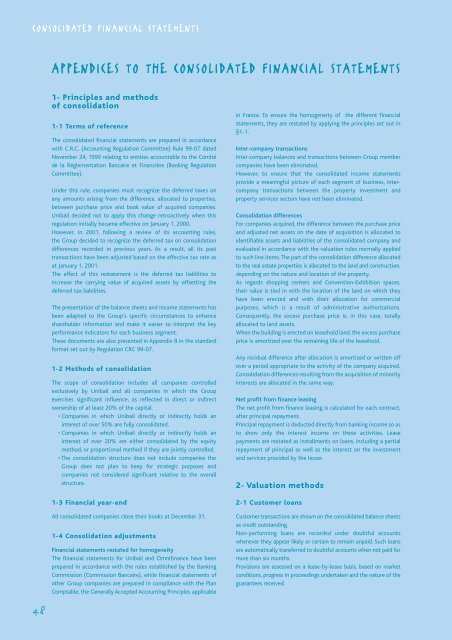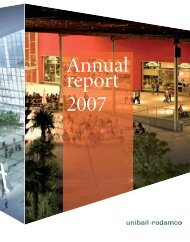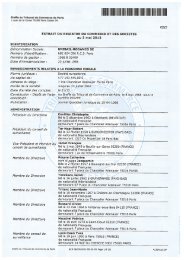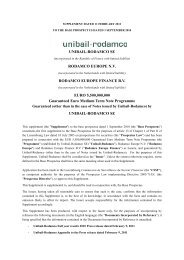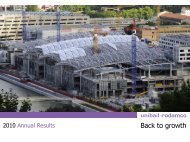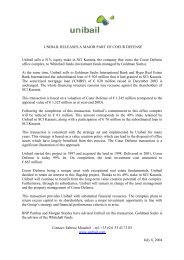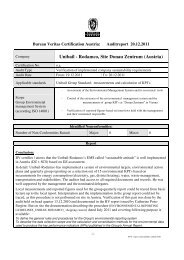2001 Annual Report - Unibail-Rodamco
2001 Annual Report - Unibail-Rodamco
2001 Annual Report - Unibail-Rodamco
You also want an ePaper? Increase the reach of your titles
YUMPU automatically turns print PDFs into web optimized ePapers that Google loves.
CONSOLIDATED FINANCIAL STATEMENTS<br />
APPENDICES TO THE CONSOLIDATED FINANCIAL STATEMENTS<br />
48<br />
1- Principles and methods<br />
of consolidation<br />
1-1 Terms of reference<br />
The consolidated financial statements are prepared in accordance<br />
with C.R.C. (Accounting Regulation Committee) Rule 99-07 dated<br />
November 24, 1999 relating to entities accountable to the Comité<br />
de la Réglementation Bancaire et Financière (Banking Regulation<br />
Committee).<br />
Under this rule, companies must recognize the deferred taxes on<br />
any amounts arising from the difference, allocated to properties,<br />
between purchase price and book value of acquired companies.<br />
<strong>Unibail</strong> decided not to apply this change retroactively when this<br />
regulation initially became effective on January 1, 2000.<br />
However, in <strong>2001</strong>, following a review of its accounting rules,<br />
the Group decided to recognize the deferred tax on consolidation<br />
differences recorded in previous years. As a result, all its past<br />
transactions have been adjusted based on the effective tax rate as<br />
at January 1, <strong>2001</strong>.<br />
The effect of this restatement is the deferred tax liabilities to<br />
increase the carrying value of acquired assets by offsetting the<br />
deferred tax liabilities.<br />
The presentation of the balance sheets and income statements has<br />
been adapted to the Group’s specific circumstances to enhance<br />
shareholder information and make it easier to interpret the key<br />
performance indicators for each business segment.<br />
These documents are also presented in Appendix 8 in the standard<br />
format set out by Regulation CRC 99-07.<br />
1-2 Methods of consolidation<br />
The scope of consolidation includes all companies controlled<br />
exclusively by <strong>Unibail</strong> and all companies in which the Group<br />
exercises significant influence, as reflected in direct or indirect<br />
ownership of at least 20% of the capital.<br />
• Companies in which <strong>Unibail</strong> directly or indirectly holds an<br />
interest of over 50% are fully consolidated.<br />
• Companies in which <strong>Unibail</strong> directly or indirectly holds an<br />
interest of over 20% are either consolidated by the equity<br />
method, or proportional method if they are jointly controlled.<br />
• The consolidation structure does not include companies the<br />
Group does not plan to keep for strategic purposes and<br />
companies not considered significant relative to the overall<br />
structure.<br />
1-3 Financial year-end<br />
All consolidated companies close their books at December 31.<br />
1-4 Consolidation adjustments<br />
Financial statements restated for homogeneity<br />
The financial statements for <strong>Unibail</strong> and Omnifinance have been<br />
prepared in accordance with the rules established by the Banking<br />
Commission (Commission Bancaire), while financial statements of<br />
other Group companies are prepared in compliance with the Plan<br />
Comptable, the Generally Accepted Accounting Principles applicable<br />
in France. To ensure the homogeneity of the different financial<br />
statements, they are restated by applying the principles set out in<br />
§1-1.<br />
Inter-company transactions<br />
Inter-company balances and transactions between Group member<br />
companies have been eliminated.<br />
However, to ensure that the consolidated income statements<br />
provide a meaningful picture of each segment of business, intercompany<br />
transactions between the property investment and<br />
property services sectors have not been eliminated.<br />
Consolidation differences<br />
For companies acquired, the difference between the purchase price<br />
and adjusted net assets on the date of acquisition is allocated to<br />
identifiable assets and liabilities of the consolidated company and<br />
evaluated in accordance with the valuation rules normally applied<br />
to such line items.The part of the consolidation difference allocated<br />
to the real estate properties is allocated to the land and construction,<br />
depending on the nature and location of the property.<br />
As regards shopping centers and Convention-Exhibition spaces,<br />
their value is tied in with the location of the land on which they<br />
have been erected and with their allocation for commercial<br />
purposes, which is a result of administrative authorizations.<br />
Consequently, the excess purchase price is, in this case, totally<br />
allocated to land assets.<br />
When the building is erected on leasehold land, the excess purchase<br />
price is amortized over the remaining life of the leasehold.<br />
Any residual difference after allocation is amortized or written off<br />
over a period appropriate to the activity of the company acquired.<br />
Consolidation differences resulting from the acquisition of minority<br />
interests are allocated in the same way.<br />
Net profit from finance leasing<br />
The net profit from finance leasing is calculated for each contract,<br />
after principal repayment.<br />
Principal repayment is deducted directly from banking income so as<br />
to show only the interest income on these activities. Lease<br />
payments are restated as installments on loans, including a partial<br />
repayment of principal as well as the interest on the investment<br />
and services provided by the lessor.<br />
2- Valuation methods<br />
2-1 Customer loans<br />
Customer transactions are shown on the consolidated balance sheets<br />
as credit outstanding.<br />
Non-performing loans are recorded under doubtful accounts<br />
whenever they appear likely or certain to remain unpaid. Such loans<br />
are automatically transferred to doubtful accounts when not paid for<br />
more than six months.<br />
Provisions are assessed on a lease-by-lease basis, based on market<br />
conditions, progress in proceedings undertaken and the nature of the<br />
guarantees received.


